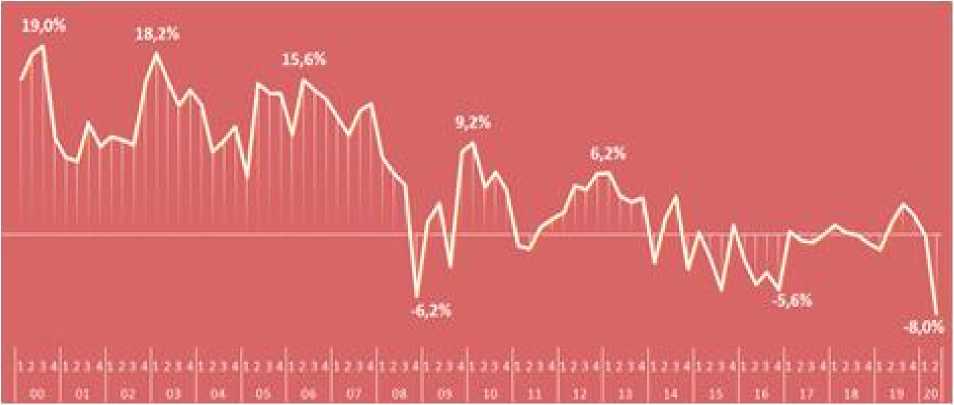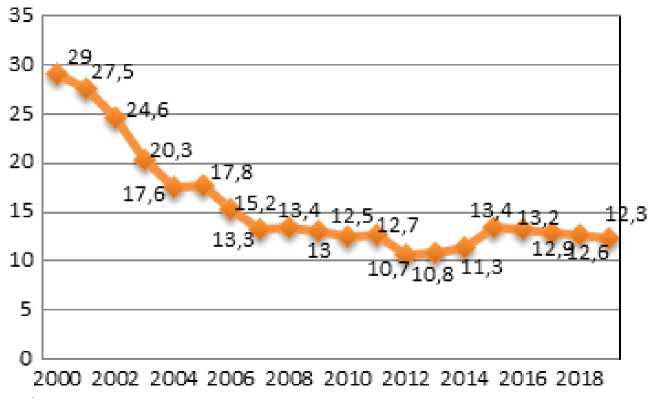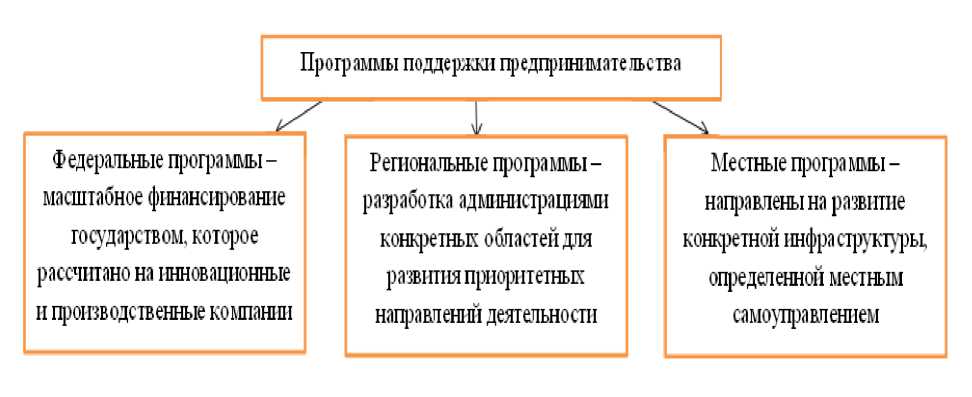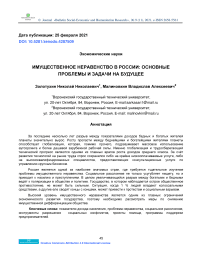Имущественное неравенство в России: основные проблемы и задачи на будущее
Автор: Золотухин Николай Николаевич, Малиновкин Владислав Алексеевич
Журнал: Bulletin Social-Economic and Humanitarian Research @bulletensocial
Статья в выпуске: 9 (11), 2021 года.
Бесплатный доступ
За последние несколько лет разрыв между показателями доходов бедных и богатых жителей планеты значительно вырос. Росту пропасти между беднейшими и богатейшими жителями планеты способствует глобализация, которая, помимо прочего, подразумевает массовое использование аутсорсинга и более дешевой зарубежной рабочей силы. Именно глобализация и трудосберегающий технический прогресс являются одними из главных врагов роста доходов среднего класса. За счёт развития технологий на рынке труда спрос сохранился либо на крайне низкооплачиваемые услуги, либо на высококвалифицированных специалистов, предоставляющих консультационные услуги по управлению крупным бизнесом. Россия является одной из наиболее значимых стран, где требуется тщательное изучение проблемы имущественного неравенства. Социальное расслоение не только усугубляет нищету, но и приводит к насилию и преступлениям. В целом увеличивающийся разрыв между богатыми и бедными ведёт к поляризации в обществе и политике. Государство, в котором наблюдается острое общественное противостояние, не может быть сильным. Ситуация, когда 1 процент людей владеют колоссальными средствами, а другие еле сводят концы с концами, может привести к протестам и социальным взрывам. Высокий уровень имущественного неравенства является одним из главных ограничений экономического развития государства, поэтому необходимо рассмотреть меры по снижению имущественной дифференциации общества.
Показатели дохода населения, проблема неравенства, социальное расслоение, инструменты разрешения социальных конфликтов, проекты помощи, программы поддержки предпринимателей
Короткий адрес: https://sciup.org/14118425
IDR: 14118425 | DOI: 10.5281/zenodo.4287509
Текст научной статьи Имущественное неравенство в России: основные проблемы и задачи на будущее
Социальное и имущественное неравенство является актуальной проблемой для многих стран мира, разрешение которой ищут многие эксперты ООН, понимая угрозу для экономического роста стран. Учитывая данные банка Credit Suisse, Россия считается одной из тех стран, которые испытывают серьезное проблемы с социальным неравенством, то есть показатели количества долларовых миллиардеров за 2019 год увеличились в 1,5 раза с данными 2018 года. Статистика показывает, что около 10% российского населения контролируют 83% национального дохода, когда 1% занимает практически 60% всех материальных и финансовых активов. Неутешительные результаты показывают и данные Росстата, в которых в первом квартале 2019 года было насчитано около 20,9 млн человек, живущих ниже официального уровня бедности, в втором квартале – около 49,6% семей, чей доход был рассчитан на минимальные потребности такие как, еда и оплата коммунальных услуг.
Стоит отдельно рассмотреть и данные Росстата за нынешний год, в котором вирус Covid-19 значительно повлиял на все слои общества в Российской Федерации. Безусловно, карантинные меры сказались на уменьшение показателей дохода населения страны, а именно в первом квартале упадок вышел на 4,8%, во втором – на 8,4% (рис.1). На снижение доходов также повлиял высокий уровень безработицы, который в начале года составлял 4,7%, а в августе – 6,4%. Минэкономразвитие прогнозирует снижение безработицы до 5,7% к концу 2020 года. Но все вышеуказанные снижения не влияют на продолжительный рост зарплат в стране, по данным Федеральной налоговой службы в период с января по август 2020 года уровень зарплаты вырос на 2,6%.

Рис.1. Доходы населения России в % по кварталам за 2000-2020 гг.
Данные показатели в общей мере усложнили проблему неравенства между разными слоями общества, так как крупные и средние предприятия в период пандемии пострадали в меньшей степени, чем предпринимательская деятельность малого бизнеса. За второй квартал предпринимательские доходы упали до минимума в отличие от доли социальных выплат среди денежных поступлений. Кризис 2020 года оказал влияние на 6,1% работающего населения, переведя его в категорию бедных, 8,7% населения потеряли работу, а 3,9% остались с доходом, не превышающим минимального уровня.
II. МАТЕРИАЛЫ И МЕТОДЫ
Вышеуказанные показатели указывают на актуальность данной проблемы в стране, которая требует тщательного рассмотрения и ведения работ по сокращению имущественного неравенства между бедным и богатым слоями населения. Государство не игнорирует ситуацию в стране, старается обеспечить формирование среднего класса и создание общества оптимального баланса. Существуют различные особенности социального расслоения в России. По причине значительного разрыва между доходами богатого и бедного населения страны появилось такое понятие как «субъективная беднота». Из-за разного уровня доходов 40% населения ощущают себя нищими по сравнению с олигархами, хотя таковыми не являются. Это люди, чей доход не позволяет им приобрести дорогостоящую технику, оплатить платное обучение ребенка в престижном университете, но для них создан социальный минимум, их прибыль позволяет удовлетворить минимальные потребности.
Также стоит рассмотреть и территориальный фактор, который играет немаловажную роль в разрыве между слоями населения. В крупных городах страны наблюдается высокий уровень дохода населения, а в сельской местности виден только низкий уровень жизни по причине недостаточного количества высокооплачиваемых рабочих мест и полного отсутствия развитого производства (рис.2). Показатели доходов населения, их бюджетной обеспеченности напрямую зависят от региона и качества проводимой в нем бюджетной политики. Поэтому географическое расположение населения по территории Российской Федерации влияет на региональное неравенство, и решением данной проблемы может быть в создании агломераций, где населению будет предоставлено множество возможностей по увеличению уровня своего дохода, где их труд будет востребован и нужен. На данный момент данная политика имеет сложности из-за различных факторов таких как, транспортные проблемы и проблемы рынка жилья, но государство пытается максимально минимизировать все неудобства, чтобы смягчить неравенство населения. Еще одним вариантом для разрешения проблемы является развитие промышленности в регионах с низким уровнем жизни, открытие новых бизнес-проектов, что позволит смягчить неравенство. На данный момент более 70 регионов страны с учетом рекомендаций Минтруда изучили и разработали собственные региональные программы, на реализацию которых государство выделяет материальную помощь. Основной упор в данных проектах делается да обеспечение нормальных условий для дошкольного и школьного образования и медицинского обслуживания населения.

Рис.2.Численность населения с денежными доходами ниже величины прожиточного минимума в России с 2000-2020 гг.
III. ОБСУЖДЕНИЕ И РЕЗУЛЬТАТЫ
Основными инструментами для решения социальных конфликтов и исправления сложившегося имущественного неравенства являются контроль государства, борьба с коррупцией и налоговая политика, которая поддерживает стабильность и выравнивает доходы населения страны. На данный момент происходит завершение работ над проектом Общенационального плана действий, который предоставляет восстановление занятости и доходов населения, обеспечивает долгосрочные изменения в структуре экономики и ее рост, учитывая, что ряд мероприятий уже успешно выполняется, а сам проект синхронизирован с планом бюджета на последующие 3 года. Правительство понимает необходимость улучшения доходных показателей населения страны, это восстановление занятости и платежеспособного спроса, предоставление помощи для малого, среднего и индивидуального предпринимательства, а также запуск нового инвестиционного цикла.
23 сентября 2020 года на заседании Правительства РФ была рассмотрена разработка Национальной программы социально-экономического развития Дальнего Востока до 2024 года с дальнейшей пятнадцатилетней перспективой. В указе Президента, который и поручил разработать данную программу, обозначены основные цели государственной политики в регионах Дальнего Востока, а именно изменение показателей качества жизни населения в лучшую сторону, улучшение демографической ситуации, а также сокращение миграционного оттока. Для реализации данного плана необходимо выполнить масштабный объем работ во многих направлениях деятельности, к примеру предоставление населению возможностей по увеличению уровня своего дохода, что потребует создание различных комфортных условий таких как, достойная оплата труда, современное жилье. Выполнение программы предоставляет позитивные долгосрочные перспективы, в которых за ближайшее время будет происходить значительный рост всех показателей экономики, увеличение объема жилищного строительства к 2024 году, создание более 200 предприятий и 30 тысяч новых рабочих мест. Национальная программа позволяет решить многие экономические проблемы, в том числе и имущественное неравенство населения, задачи стратегии уже включены в ряде других действующих проектах и программ государства.
С 2021 года планируется изменение ставки налога на доходы с 13 до 15 % для физических лиц, чей ежегодный доход составляет более 5 млн. рублей. Правительство максимально упростило процедуру сбора документов, перенеся выполнение данной работы на налоговую службу, которая и направит налогоплательщикам уведомление в конце года о требуемых выплатах. Поступившие в бюджет деньги будут направлены на лечение детей с тяжелыми заболеваниями. Данный законопроект учитывает и тот фактор, что требуется уточнение какие виды доходов стоит оставить в проекте, а какие исключить. Поэтому Министерство финансов совместно с парламентом и регионами страны должны определить базу для налога. Подход считается справедливым, увеличивается ответственность людей с доходом выше среднего и уменьшаются тем самым социальные конфликты между разными слоями населения.
Особо важной проблемой, которая требует тщательного рассмотрения и помощи государства, это обеспечение техническими средствами реабилитации людей с инвалидностью. На данный момент техника предоставляется государством через Фонд социального страхования, но также можно совершить компенсацию за уже выполненный ремонт или покупку. Также вводится новый механизм приобретения технических, жизненно-необходимых вещей с помощью электронных сертификатов, которые без дополнительных согласований сам человек с инвалидностью может использовать для любого требуемого технического оснащения. Применение и выбор предоставляется самому человеку, процесс покупки или ремонта станет значительно легче и проще. В ближайшие пару лет планируется применять данные электронные сертификаты для обеспечения льготников требуемыми лекарствами и медикаментами, а детям с инвалидностью будет предоставлено обязательное лечебное питание. Данные новшества позволяют уменьшить затраты на требуемое техническое оснащение и медицинские средства, что повлияет на доходы населения страны.
Помимо вышеуказанных законопроектов, правительство продолжает рассматривать проблему значительного упадка доходов предпринимательской деятельности малого и среднего бизнеса.
Была создана программа помощи малому и среднему бизнесу от государства в 2020 году, которая определена в соответствии с критериями, установленными законом № 209 - ФЗ от редакции от 27 января 2019 года (рис.3).
|
Формат |
Количество работников (чел) |
Финансовый оборот за 12 месяцев (шн.рублей) |
|
Микропредприятне |
<15 |
<120 |
|
Малое предприятие |
<100 |
<800 |
|
Среднее предприятие |
<250 |
<2000 |
Рис.3. Виды малого бизнеса
На данный момент в Российской Федерации существует около 650 программ поддержки предпринимательства, которые распределяются в зависимости от рода деятельности и реализуются на различных уровнях, начиная от государственного, заканчивая поддержкой в пределах одного региона или населенного пункта (рис.4).

Рис.4. Классификация программ помощи предприятиям от государства
Несмотря на уже реализованные проекты помощи, правительство продолжает совершенствовать программы поддержки предпринимательской деятельности малого и среднего бизнеса. Планируется утверждение поправок в законопроект, который изменяет правила формирования реестра субъектов, чтобы он обновлялся каждый месяц, а не раз в год, тем самым предприятия будут способны восстановить свои права, если они по каким-либо причинам выпадут из реестра. Данные новшества позволят улучшить положение предпринимателей и увеличить показатели своих доходов.
Реализация всех проектов помощи населению страны от государства даст огромный шаг к выполнению национальной цели «Достойный, эффективный труд и успешное предпринимательство», которое предполагает к 2030 году обеспечить значительный рост валового внутреннего продукта при сохранении социально-экономической стабильности, то есть возвращение роста доходов населения. Так, планируется поэтапный переход на установление долгосрочных тарифов на услуги естественных монополий, в том числе развитие института "регуляторного контракта", создание и развитие регистратора финансовых операций на электронных финансовых платформах, а также реализация региональных механизмов защиты и поощрения капиталовложений во всех субъектах РФ.
IV. ЗАКЛЮЧЕНИЕ
Изменение социального имущественного неравенства в России возможно при разрешении проблем на рынке труда, совершенствовании антидискриминационного законодательства, реализации перераспределительного потенциала систем налогообложения, борьба с коррупцией, правовое оформление четких и понятных норм социальной справедливости и обеспечения равного доступа к правосудию и равенства перед законом. При реализации рассмотренных нами законопроектов Российской Федерации будет возможно создание оптимального баланса и уменьшение социальных конфликтов в стране.
Список литературы Имущественное неравенство в России: основные проблемы и задачи на будущее
- Bashkatova A. (2013) 20 years to fight inequality. Nezavisimaya gazeta. Pp.10-14 (in Russ).
- Bazylev N.I., Gurko S.P., Bazyleva M.N. (2013) Economic theory. INFRA-M. Pp.99-104 (in Russ).
- Belousova S. (2012) Poverty Level Analysis. The Economist.№10. Pp.88-90 (in Russ).
- Belova T.N. (2014) On the choice of the average form for assessing the standard of living of the population. Problems of Statistics. №2. Pp.39-43 (in Russ).
- Bobkov V. (2012) Russian poverty: measurement and ways of overcoming. Society and Economy. Pp.246-252 (in Russ).
- Bulatov A.S. (2013) Economics: textbook. Economist, Pp.896-903 (in Russ).
- Chepurin M.N. (2014) The course of economic theory: textbook. ASA. Pp.832-834 (in Russ).
- Claudia Goldin, Lawrence Katz (2008) The Race between Education and Technology. Harvard University Press, NBER Working Paper. №12984. Pp. 15-19. (in Russ).
- Daron Aceoglu, James Robinson (2012) Why Nations Fail. Crown Publishing. Pp. 12-15 (in Russ).
- Davydova N.M., Sedova N.N. (2012) The rich and the poor in modern Russia. SOTSIS. № 3. Pp.308-312 (in Russ).
- Equity and Development (2006) World Bank Report. License: CC BY 3.0 IGO. Pp. 44-46 (in Russ).
- Ershov B. A., Semenkova E. V. (2016) The consequences of the collapse of the Soviet Union. International Journal of Humanities and Natural Sciences. № 3. Pp. 20-22. (in Russ).
- Ershov B.A. (2011) Family foundations of the life of priests in the provinces of the Central Chernozem region in the XIX century. Historical, philosophical, political and legal Sciences, cultural studies and art history. Questions of theory and practice. № 2-2 (8). Pp. 68-71. (in Russ).
- Ershov B.A., Perevozchikova L.S. (2019) Preaching work of the Russian Orthodox Church in the early XX century. 6th International Conference on Education and Social Sciences. Abstracts & Proceedings. Pp. 202-207. (in Engl).
- Ershov B.A., Volkova E.A., Frolova E.V., Volkov N.M., Pletnev V.I. (2019) The Revolution of 1905-1907. In Russia: results and consequences. 6th International Conference on Education and Social Sciences. Abstracts & Proceedings. Pp. 213-220. (in Engl).
- Vechkanov G.S. (2012) Economic theory. Textbook for universities, 2nd edition. Piter-Press. Pp.45-48 (in Russ).
- Gulenkova A., Krinko E. (2011). How to Measure Poverty. Social work. Pp.210-214 (in Russ).
- Ivanova S.T. (2012) Russia in a state of crisis. SOTSIS. Pp.360-366 (in Russ).
- Kamaev V.D. (2014) Economic theory: textbook. Humanities. ed. center VLADOS. Pp.592-595 (in Russ).
- Kolmakov I.B. (2014) Forecasting indicators of differentiation of monetary incomes of the population. Problems of forecasting. №1. Pp.136-163 (in Russ).
- Kulikov L.M. (2011) Fundamentals of economic theory: textbook. allowance. Finance and statistics. Pp.400-412 (in Russ).
- Larry M. Bartels (2009) Unequal Democracy. The Political Economy of the New Gilded Age. Princeton University Press. Pp. 33-35 (in Russ).
- Lipsits I.V (2014) Economy. Omega-L. Pp.6-9 (in Russ).
- Litvinov V.A. (2011) Poverty of the population: indicators and measures. Teaching history and social studies at school. Pp.401-405 (in Russ).
- Litvintseva G.P. (2012) Monetary incomes of the population of the regions of Russia taking into account the purchasing power of the ruble and hidden incomes. Questions of statistics. №6. Pp.12-14 (in Russ).
- Lugovoi O. Y. (2015) Microeconomics: textbook. allowance. Publishing house of the OGPU. Pp.184-190 (in Russ).
- Mechetnaya N. (2013) Economy: summed up the line. Correspondent. Pp. 8-11. (in Russ).
- Mitsek S.A. (2015) Production function, income distribution and economic growth in the Russian Federation. Finance and credit. №29. Pp.75-77 (in Russ).
- Nikitin S. (2012) Personal incomes of the population. MEiMO. №2. Pp.16-23 (in Russ).
- Novikova V. (2013) Is it possible to have a fair distribution of income.The Economist.№4. Pp.61-67 (in Russ).
- Protsenko A. (2013) The rich poor and the poor rich. Labor. Pp.47-52 (in Russ).
- Russian economic journal. (2012). №7. Pp.17-19 (in Russ).
- Social sphere (2012). Problems of Economics. №1. Pp.16-20 (in Russ).
- Social sphere (2014). Problems of Economics.№12. Pp.17-20 (in Russ).
- Vasiliev Y.G. (2011) Poor about the poor. Social work. № 3. Pp.143-145 (in Russ).
- Vidyapin V.I. (2015) Economic theory: textbook. INFRA-M. Pp.672-681 (in Russ).
- Vodianova M., Dokuchaev D. (2010) The rich come off. New time. Pp.16-19 (in Russ).
- Zagaytov I.B., Yanovskiy L.P. (2012) Dynamics of solvency and depopulation of the population in the
- Russian Federation. Problems of forecasting. №1. Pp.139-149 (in Russ).
- Zubkova L. (2011) Poverty is not a vice. Social protection. Pp. 311-316 (in Russ).


